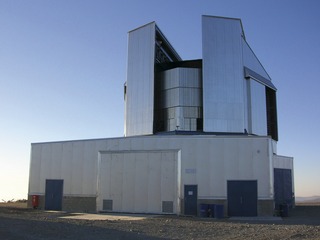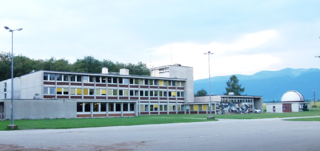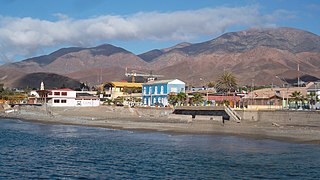You can help expand this article with text translated from the corresponding article in Spanish. (January 2015)Click [show] for important translation instructions.
|
| |||||
| Decades: | |||||
|---|---|---|---|---|---|
| See also: | |||||
The following lists events that happened during 2009 in Chile.
You can help expand this article with text translated from the corresponding article in Spanish. (January 2015)Click [show] for important translation instructions.
|
| |||||
| Decades: | |||||
|---|---|---|---|---|---|
| See also: | |||||
The following lists events that happened during 2009 in Chile.

The Very Large Telescope (VLT) is an astronomical facility operated since 1998 by the European Southern Observatory, located on Cerro Paranal in the Atacama Desert of northern Chile. It consists of four individual telescopes, each equipped with a primary mirror that measures 8.2 meters in diameter. These optical telescopes, named Antu, Kueyen, Melipal, and Yepun, are generally used separately but can be combined to achieve a very high angular resolution. The VLT array is also complemented by four movable Auxiliary Telescopes (ATs) with 1.8-meter apertures.

The European Organisation for Astronomical Research in the Southern Hemisphere, commonly referred to as the European Southern Observatory (ESO), is an intergovernmental research organisation made up of 16 member states for ground-based astronomy. Created in 1962, ESO has provided astronomers with state-of-the-art research facilities and access to the southern sky. The organisation employs over 750 staff members and receives annual member state contributions of approximately €162 million. Its observatories are located in northern Chile.

A Ritchey–Chrétien telescope is a specialized variant of the Cassegrain telescope that has a hyperbolic primary mirror and a hyperbolic secondary mirror designed to eliminate off-axis optical errors (coma). The RCT has a wider field of view free of optical errors compared to a more traditional reflecting telescope configuration. Since the mid 20th century, a majority of large professional research telescopes have been Ritchey–Chrétien configurations; some well-known examples are the Hubble Space Telescope, the Keck telescopes and the ESO Very Large Telescope.

The Cenepa War or Third Ecuadorian-Peruvian War, also known as the Alto Cenepa War, was a brief and localized military conflict between Ecuador and Peru, fought over control of an area in Peruvian territory near the border between the two countries. The two nations had signed a border treaty following the Ecuadorian–Peruvian War of 1941, but Ecuador later disagreed with the treaty as it applied to the Cenepa and Paquisha areas, and in 1960 it declared the treaty null and void. Most of the fighting took place around the headwaters of the Cenepa River.

The Atlas Cheetah is a South African fighter aircraft designed and produced by the aviation company Atlas Aircraft Corporation. It was developed at the behest of, and principally operated by, the South African Air Force (SAAF).

The Dassault Mirage 5 is a French supersonic attack aircraft/fighter-bomber designed by Dassault Aviation during the 1960s and manufactured in France and other countries. It was derived from Dassault's popular Mirage III fighter and spawned several variants of its own, including the IAI Kfir. In Pakistan's service, the Mirage 5s are modified and are capable of nuclear weapons delivery.
VST may refer to:

The VLT Survey Telescope (VST) is a telescope located at ESO's Paranal Observatory in the Atacama Desert of northern Chile. It is housed in an enclosure immediately adjacent to the four Very Large Telescope (VLT) Unit Telescopes on the summit of Cerro Paranal. The VST is a wide-field survey telescope with a field of view twice as broad as the full Moon. It is the largest telescope in the world designed to exclusively survey the sky in visible light.

The VISTA is a wide-field reflecting telescope with a 4.1 metre mirror, located at the Paranal Observatory in Chile. It is operated by the European Southern Observatory and started science operations in December 2009. VISTA was conceived and developed by a consortium of universities in the United Kingdom led by Queen Mary University of London and became an in-kind contribution to ESO as part of the UK's accession agreement, with the subscription paid by the UK Science and Technology Facilities Council (STFC).

La Silla Observatory is an astronomical observatory in Chile with three telescopes built and operated by the European Southern Observatory (ESO). Several other telescopes are also located at the site and are partly maintained by ESO. The observatory is one of the largest in the Southern Hemisphere and was the first in Chile to be used by ESO.

Paranal Observatory is an astronomical observatory operated by the European Southern Observatory (ESO). It is located in the Atacama Desert of Northern Chile on Cerro Paranal at 2,635 m (8,645 ft) altitude, 120 km (70 mi) south of Antofagasta. By total light-collecting area, it is the largest optical-infrared observatory in the Southern Hemisphere; worldwide, it is second to the Mauna Kea Observatory on Hawaii.

ESO Hotel at Cerro Paranal is the accommodation for Paranal Observatory in Chile since 2002. It is mainly used for the ESO scientists and engineers who work there on a roster system. It has been called a "boarding house on Mars", because the desert surroundings are Mars-like, and an "Oasis for astronomers". It is not a commercial hotel, and the public cannot book rooms.

The Geneva Observatory is an astronomical observatory at Sauverny (CH) in the municipality of Versoix, Canton of Geneva, in Switzerland. It shares its buildings with the astronomy department of the École Polytechnique Fédérale de Lausanne. It has been active in discovering exoplanets, in stellar photometry, modelling stellar evolution, and has been involved in the European Space Agency's Hipparcos, INTEGRAL, Gaia, and Planck missions.

Taltal is a Chilean commune and city in Antofagasta Province, Antofagasta Region. According to the 2012 census, the commune has a population of 11,132 and has an area of 20,405.1 km2 (7,878 sq mi). The commune is home to Paranal Observatory and includes the northern portion of Pan de Azúcar National Park.

Cerro Armazones is a mountain located in the Sierra Vicuña Mackenna of the Chilean Coast Range of Andes, approximately 130 km (81 mi) south-east of Antofagasta in the Antofagasta Region, Chile. The mountain is located in a privileged zone for optical astronomy because it has 89% cloudless nights a year. On 26 April 2010, the European Southern Observatory Council selected Cerro Armazones as the site for the planned Extremely Large Telescope (ELT); the construction began in June 2014, and the first light is expected in 2027. Before the construction of the ELT began, the elevation of Cerro Armazones had been 3,064 metres (10,052 ft), but now the top is truncated and the resulting plateau is several meters lower.

VISTA Variables in the Via Lactea –TheVVV Survey– is observing the Milky Way's bulge and southern disk in the near-infrared using the capabilities of the VISTA Telescope at Paranal, Chile.

Cerro Murphy Observatory is an international astrophysical project hosted by the ESO Paranal Observatory and operated by the Nicolaus Copernicus Astronomical Center of the Polish Academy of Sciences. The observatory is located on Cerro Murphy, which is a hill located 1 kilometre (0.62 mi) to the southwest and 230 metres (750 ft) below the summit of Cerro Armazones, a mountain in the Antofagasta Region of Chile, 120 km (75 mi) south of Antofagasta. OCM is located at 2,817 m (9,242 ft) altitude and currently houses 5 telescopes, whose diameters range between 0.3 and 1.5 m.

The Next-Generation Transit Survey (NGTS) is a ground-based robotic search for exoplanets. The facility is located at Paranal Observatory in the Atacama desert in northern Chile, about 2 km from ESO's Very Large Telescope and 0.5 km from the VISTA Survey Telescope. Science operations began in early 2015. The astronomical survey is managed by a consortium of seven European universities and other academic institutions from Chile, Germany, Switzerland, and the United Kingdom. Prototypes of the array were tested in 2009 and 2010 on La Palma, and from 2012 to 2014 at Geneva Observatory.
Science tourism is a travel topic grouping scientific attractions. It covers interests in visiting and exploring scientific landmarks, including museums, laboratories, observatories and universities. It also includes visits to see events of scientific interest, such as solar eclipses.